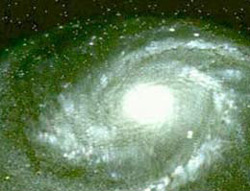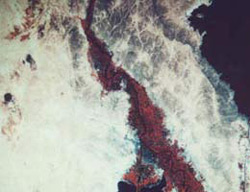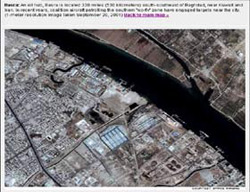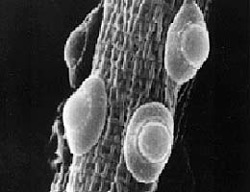>> introduction
short overview
>> seeing
things/
knowledge
produktion
>> PCM/
'Visibility
is a trap'
>> Latour
- Pasteur/
the
scientific image
>> Abstraction/
the paradox
status
of the visual abstract
>> Conclusion/
outlining
along two strings
----------------
>> Print entire
text
(4 pages)
pdf
or .rtf
----------------
>> movies
(select the format)
1. science
> mov
> wmv
2. pre-post
> mov
> wmv
3. nightsight
> mov
> wmv |
Introduction:
During the 20th century western societies, especially at the level of
their constitution of social communities, shifted from mechanic towards
a dominating scientific approach of interpretation. Simultaneously the
development of the evolving role of communication media established a
mainly visual-based set of codes, forcing radical transformations in the
methods of establishing evidence. The further change towards a digital
society brought the idea of manipulation into focus. The occuring shift
from authentic artifacts as documents to compiled electronic codes as
signs established through information educed a new sense of subtle insecurity
concerning the visual. The systemic ontological insecurity lead to different
kinds of societal responses – in creating an ambivalent reading,
which allowed to recognize formerly unseen/invisible aspects. At the same
instant it endangered the defining normative implying that there was no
verifiable reflection of the logic underlying the existing social order.
One set of responses to this condition of insecurity (in the media as
well as in the relations to society that it represents) was to place even
more belief and emphasis on the concrete rationalisation of scientific
methodology as a means of concretely ascertaining ‘reality’
– proved through visuals. Thus the characteristics of scientific
approach became attached even to the visualisation of everyday experience
and environment, as shown in mass media. Yet the methods used for establishing
evidence are themselves in a constant state of transformation, and so
as well what is authentically certifiable as ‘solid’ truthful
characteristics of visualisations.
The tenuity of all these constructions is especially evident in moments
of crisis, like now in this period after Sept.11/01, which thus allows
to focus more clearly on major strategies of the constitution of social/cultural
representation. These constructions work to decrease any form of ambivalence
and emerging uncertainty by introducing a variety of different strategies
of perception, which form a steady-state equilibrium of agreement that
validates as if concrete fact.
In respect of this I refer to the example of Latour’s
analysis of Pasteur’s scientific testing methods of ‘visualisation’,
which he refuses to accept as a pure evidential proof.
Instead he renders the evolving knowledge production into a social paranoid
neurosis referring to a predetermined reading of a thereby established
‘truth’. Considering paranoia like in the analysis of Lacan
as a ‘radical uncertainty that compels the subject to search for
the 'objectifying souvenirs' that will verify experience as real or delusional’,
I outline a correspondence to the western predefined view onto the world.
In regard of the established set-up the changing possibilities and increasing
ambivalence of sight and vision are almost totally ignored or trapped
into the idea of an intermingling concept of reality and virtuality. The
steady re-establishment of predefined cultural frames of vision, which
uses preferred reading methods for the consolidation of itself, ignores
the more flexible possibilities of the full sight, which information/technologies
are able to develop.
|
>>> click into the images to enlarge

milkyway
 satellite image of Euphrat Delta
satellite image of Euphrat Delta

satellite image of Basra / Iraq

Meloidogyne parasitized by Pasteuria penetrans |